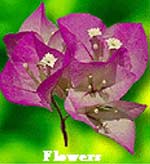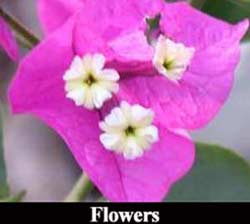|
Future of genetic
engineering and bougainvillaea flowers in Sindh-Pakistan
By Farzana
Panhwar
The plant is named after French navigator de Bougainvillaea
who carried it to in the ship to fame. It belongs to
Four-Q-Clock family (Nyctaginaceae). The genous
bougainvillaea, contains several species but only three are
important. It is an ornamental climber. It also called paper
flower.

Bougainvillaea (pukanawila) is a woody vine. It is common both
in tropical and sub-tropical regions of the world. Usually it
needs pruning to give a shape of hedge, small tree, shrub,
with single trunk which can be go up to 20 feet diameter.
After pruning it produces heavy flowers. Although flowers
pattern is affected with day length and temperature. The plant
produces flowers, only at temperature 21-30°C.
The common bougainvillaea found in the Philippines, Kenya,
tropical and sub-tropical regions is called bougainvillaea
spectabilis (purple colour flower) having two variant
Bougainvillaea glabra having large magenta or purple bract and
Bougainvillaea Peruviana bracket with lavender to rosy-round
purple bracts.
Flowers.
It produces flowers which are hermaphrodite of purple, red,
orange and white colours, each flower have three bract, in
which veins are connected with tubular flowers. Each flower is
a perfect flower having petal, stamens and pistil surrounded
by a long tube. Fruit is small dry 5-ribbed achene.
Some flowers have double bracts. Double forms tends to carry
their blooms near the end of the stem rather than distributing
them evenly over the plant. Some flowers of Bougainvillaea
have hard texture, can retain their shape after drying, while
those flowers having soft texture will shrivel up after
drying. Flowering period in Sindh is throughout the year
except in May to July but, big flush comes March to April and
October-November.. Moderate temperature plus longer night
result into more flower flush.
Varieties.
The common varieties in Pakistan are: Bougainvillaea glabra,
B. Louis Wathin, Mrs. Butt (Bilatereta) spectabilis splendens,
white Bougainvillaea while other varieties are:
California Gold, Vickie, Juanita Hatten, Barbara Karst,
Jamaica White, Sundown, Double Pink, Texas Dawn, Surprise,
Rosenka (shrub-3 feet). Bougainvillaea (Bougainvillaea
Spectabilis) and B. Brasiliensis has of bright magenta, pink,
white, gold, orange and purple flowers, red, scarlet and
lavender colour.
Bougainvillaea is divided on the basis of colour into
following groups:
Pink, rose blends.
n Bridal Bouquet: vigorous, double (multiple bracts),
pale green and pale pink.
n B. Paultonii: moderate grower, large bracts open
orange and turns pink.
n Carmencita: double (multiple bracts), magenta rose
(patented) which are further divided as:
· Indian Flame: vigorous, large leaves, heavy flower,
large bracts open orange and turn dark pink.
· Lemmer’s Special: moderate vigour, soft leaves, large
faded-rose bracts.
· Lyamunga No.2: shrubby, low grower, magenta bracts.
· Muriel Fitzpatrick: upright, large pink bracts.
· Mary Palmer: vigorous when established, large bracts,
both white and pink in same inflorescence (patented as
‘Surprise’).
n Miss Manila: vigorous, large bracts open orange and
turn rose.
n Pink Champagne: double (multiple bracts), rich pink.
n Rhodomine: vigorous, large leaves, bright magenta
bracts.
n Rose Pink: small plant, bracts open orange and turn
pink.
Gold, orange blends.
n California gold: rank grower, rich golden bracts.
n Doubloon: vigorous, double (multiple bracts),
orange-gold having five groups namely:
· Lady Marry Baring: vigorous, heavy flower, small
golden-orange bracts.
· Orange King: flowers in shade.
· Rosa Catalina: moderate in flowering habit, large
orangish bracts, young stems fuzzy like B. Pectabilis types.
· Rose Pink: small plant, bracts open orange and turn
pink.
· Yellow Glory: vigorous.
White.
Jamaica White (Snow-white): extremely vigorous, medium-sized
white bracts, often with pink tinge (patented).
Dead bracts remain on plant, making it unsightly.
Red.
n Barbara Karst: brilliant cerise bracts, vigorous
grower.
n Close burn: good inflorescence structure, light
brick-red bracts, young stems fuzzy.
n Crimson Lake: large brilliant crimson bracts.
n Kille Campbell: vigorous, large red bracts.
n Lacquer Red: vigorous red bracts (a good strong red,
no purplish tinge), orange flowers.
n Red Glory: strong grower, good foliage, red bracts,
medium sized.
n San Diego Red: bright red bracts, flowers sparse.
n Temple Fire: low growing, sparse red bracts, used as
ground cover.
n William Paulton: low grower, twiggy, small red
bracts.
Purple, mauve blends.
B. glabra ‘Indica’: large purple bracts, large leaves.
B. glabra cypheri: similar to ‘Indica’ but a smaller plant
with smaller leaves and bracts.
B. glabra magnifica: very large magenta-purple bracts, with
good arrangement of inflorescences on branch (long peduncles),
foliage dark, glossy green.
B. spectabilis: vigorous, small leaves, small purple
bracts.
Convent: low grower, leaves linear and small, purplish bracts.
Dulci Dayborn: similar to B. glabra, no flowers in shade.
Elizabeth Angus: large purple bracts.
Hugh Evans: pinkish mauve bracts.
John Latin: vigorous, mauve to pink bracts, old bracts do not
abscise.
Lilac Queen: vigorous, low grower, heavy flower, pink-lilac
bracts.
Some other cultivars.
n Afterglow.
n Betty Hendry.
n Bois de Rose.
n Buttiana.
n Dream.
n Easter Parade.
n Fascelles Purple.
n Gillian Greensmith.
n India.
n Golden Glow.
n Gopal .
n Hugh Evans.
n Jane Snook.
n Jubilee.
n Lady Hudson.
n Lateritia.
n Mrs. Butt.
n Mrs. Helen McLean.
n New River.
n Orange King.
n President.
n Purple Prince.
n Scarlet O’Hara.
Bougainvillaea is ideal for Bonsai species used for it are as
under:
B. razilinesis: Pink Pixie bougainvillaea.
B. buttiana: Golden Glow bright yellow bracts which fade
to apricot.
B. buttina:Louis Wathen: orange bracts.
B. buttina ‘Mrs. Butt’ - crimson bracts.
B. buttina ‘orange king’.
B. glabra: Paper flower, lesser bougainvillaea - The most
common species used for bonsai. It has shiny green, slightly
hair leaves and magenta colour bracts.
B. glabra ‘Magnifica’-rose pink bracts.
B. glabra ‘snow white’ - white bracts.
B. peruviana - rosy pink bracts.
B. spectabilis - pink or mauve bracts.
Plant requirements.
It needs N:P:K fertiliser at the rate of 20:20:20.
Bougainvillaea is grown at a distance of 3-15 feet depend upon
the plant requirement. Leaves are alternate, petiolate,
oblong, narrow at both ends, smooth with entire margin.
Propagation.
Vegetative growth period is the time of pruning it should be
cut at the base of the leaf. This will promote the plant to
produce new shoot.
The method of propagation is cuttings of April and May in
which 6 inch piece of diameter of pencil, is dipped into
indolebutyric acid 0.5% or naptholenacetic acid 0.5%) and
inserted into rooting medium of pure vericultite, or black
sand or composted saw dust. After 6-weeks roots develop. This
method is highly successful, although air-layering also
develop rooting but this method is not practised usually.
Uses.
In Pakistan plant is used for training on porches, arbours,
pergolas, gates, arches, pillars, house corners, walls, in
grounds and parks.
Diseases and Disorders.
The only insect which affect the bougainvillaea is caterpillar
(Asciodes gordialis). Although plant is resistant to cold but
freezing results die-back and plant burns.
Genetic Engineering.
n Most of work done to develop dwarf varieties, Dwarf
varieties only 1.5 m (5 feet) tall, these are Bambino Zuki,
Bambino Bokay, Bambino Pedro and Bambino Shala, Bambino Majik,
Bambino Miski and Bambino Krishna.
n Newly developed hybrids are Jamica white, Scarlet
O’Hara (orange-red) and Orange-king.
n Other genetically evolved hybrid are; Majik, Miski,
Nonya and Suki.
n Genetic engineering is used to develop flower having
double (multiple flower) bract it developed new vigorous
growing clones to flower earlier.
n It is used to develop new array of tools, such as
mutagensis, hybridisation selection, photo-period control,
chromosome analysis, giensa and fluorescence bonding for
promoting floriculture.
n It is used to over power propagation in which we use
somaclonal variation and biochemical aspect of morphogensis,
aiming at plant development methods for rapid multiplication
and creation of varieties and germplasm preservation.
n It helps in mass propagation through tissue culture
technology.
Conclusion.
More work is needed to study its taxonomy, biodiversity
research in diverse aspect of botany like its morphological
study, taxonomical study, its ways of conservation the
germplams, ethano-botanical studies to find seed biology,
plant pathology, entomology, plant propagation and its
breeding and other related aspects of its.
Contact: |
Pakissan.com;
|